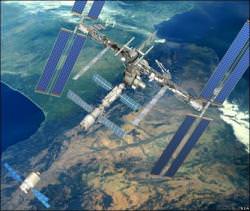Peering across 2000 km of space, the Automated Transfer Vehicle (ATV), “Jules Verne”, leads the orbit of the International Space Station (ISS). The ISS will now be a speck on the ATV’s horizon, but only hours earlier, it completed a fly-by 30 km underneath, giving the station and space shuttle Endeavour crew a look of the precious cargo shipment. Jules Verne will now sit and wait in “parking orbit” until the coast is clear for the ATV to dock early next month…
In an ultimate fly-by, the Jules Verne shot past the ISS 30 km below its orbit. A few thruster blasts later and the robotic vehicle had reached its parking orbit, 2000 km in front of the ISS. A photo was apparently taken by the ISS’s robotic arm, but the zoom wasn’t powerful enough to get any detail of the craft as it passed.
The ATV must now wait for Endeavour to finish its mission before it can approach the station. Jules Verne has passed all mission requirements so far, but it still has a few “practice runs” to carry out before it will be cleared for docking. On the 29th and 31st of March the vehicle will carry out two mock docking procedures in preparation for the real event on April 3rd.
The ATV successfully completed the Collision Avoidance Manoeuvre on March 16th, so a fail-safe docking procedure is known to be working correctly.
The ATV’s second propulsion chain was used to complete today’s manoeuvres into parking orbit and all propulsion systems seem to be fully operational. Alberto Novelli, ESA’s Mission Director at the ATV Control Centre in Toulouse, France, added:
“In doing the boosts we have tested all the pressure regulators and that worked perfectly fine. So as of today we have the proof that the propulsion system as a whole, including all the redundancies, is working fine.” – Novelli.
So the excitement continues to build for Europe’s first fully automated ISS 20 tonne supply vehicle as it patiently awaits its turn to dock with the station.
Source: ESA


Now let’s see this ATV in action.
It is an amazing feat to accomplish this unmaned docking…
the technology behind it is top notch!
hats off!
The French controllers seem a little complacement, please be careful
europe is quickly proving to be the vanguard in space technology good on you europeans.
Well done ESA and NASA.
Now how about renaming the ISS
‘Space Station Clarke’?